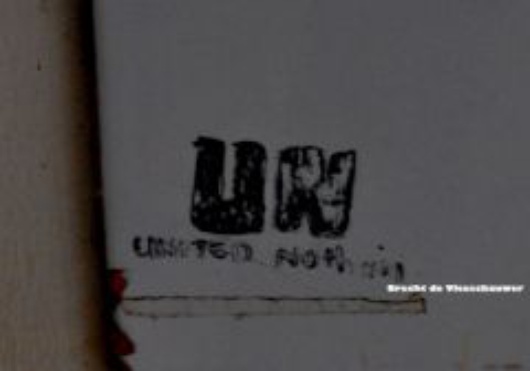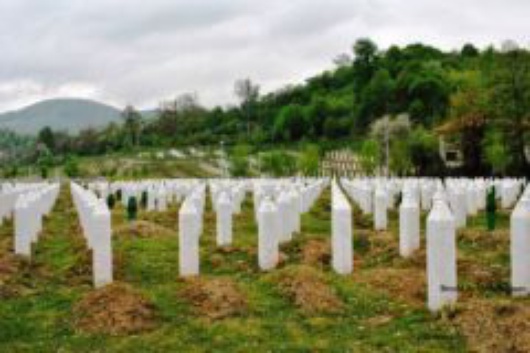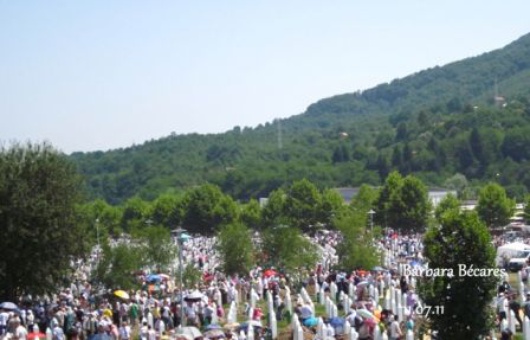A review of Srebrenica 16 years after
Published on
By Brecht de Vleeschauwer
On Monday 11 July, the Bosnian town Srebrenica commemorated the victims of the Srebrenica genocide. Srebrenica was during the Balkan war a ‘safe haven’ which means that it was a camp for Muslim refugees, protected by the Dutchbat (Dutch UN troops). In July 1995 Bosnian Serb forces overran the enclave and killed 8000 Bosnian Muslim men and boys.
After the arrest of the former Bosnian Serb General Ratko Mladic at the end of May, another historic moment happened last week. A court in The Hague judged that the Dutch state is responsible for three Srebrenica deaths. Even though Dutchbat was working under the UN flag, the court said that in this “extraordinary” situation the Dutch government became more involved with Dutchbat. That’s why they are responsible.
 Some of the victims accuse the Dutchbat of complicity in genocide. Two months ago, I visited Srebrenica. Over there I had a talk with Pim Kivits. He is a former Dutchbat soldier who was in Srebrenica in July ’95. He doesn’t have the impression that the local people blame him for what happened in 1995. “Surprisingly the people here in Srebrenica have a very neutral opinion about what happened. They tell me that they don’t blame us personally. They realise that it was just a failure of the international community in general. We were here with only 300 soldiers. 100 were able to fight, the other 200 were here for logistics support. We did everything we could, several times we asked for air support, but we never got any help.”
Today, 16 years after the drama of Srebrenica, the town and its inhabitants are still struggling.
Before the war was Srebrenica a prosperous region in Bosnia and Herzegovina with a population of about 35 000 inhabitants. Nowadays there are no official numbers, but the population is estimated at 5 to 10 000 and the unemployment rate is about 80%.
Although there have been a lot of projects for returnees, none of them could be called a success. Bojan Kovacevic is project coordinator for the United
Some of the victims accuse the Dutchbat of complicity in genocide. Two months ago, I visited Srebrenica. Over there I had a talk with Pim Kivits. He is a former Dutchbat soldier who was in Srebrenica in July ’95. He doesn’t have the impression that the local people blame him for what happened in 1995. “Surprisingly the people here in Srebrenica have a very neutral opinion about what happened. They tell me that they don’t blame us personally. They realise that it was just a failure of the international community in general. We were here with only 300 soldiers. 100 were able to fight, the other 200 were here for logistics support. We did everything we could, several times we asked for air support, but we never got any help.”
Today, 16 years after the drama of Srebrenica, the town and its inhabitants are still struggling.
Before the war was Srebrenica a prosperous region in Bosnia and Herzegovina with a population of about 35 000 inhabitants. Nowadays there are no official numbers, but the population is estimated at 5 to 10 000 and the unemployment rate is about 80%.
Although there have been a lot of projects for returnees, none of them could be called a success. Bojan Kovacevic is project coordinator for the United  Nations Development Program in Srebrenica. Also his point of view isn’t very optimistic “We have to realise that our main goal is changing. At the moment we have to prevent people from leaving, not attracting more. It would be great If we succeed in reducing the amount of people who leave the region.”
It’s an open secret that a lot of projects failed and way too much money was wasted. Muhizin Omerovic is working for the municipality of Srebrenica. He did not mince matters when he talked about the aid funds for the region. “The expression ‘the millions of Srebrenica’ stands for the money that doesn’t exist, disappeared or got stolen. Because with the money that was spend here they should be able to build a new Las Vegas over here not to keep this town in such a miserable situation as it is nowadays.”
Nations Development Program in Srebrenica. Also his point of view isn’t very optimistic “We have to realise that our main goal is changing. At the moment we have to prevent people from leaving, not attracting more. It would be great If we succeed in reducing the amount of people who leave the region.”
It’s an open secret that a lot of projects failed and way too much money was wasted. Muhizin Omerovic is working for the municipality of Srebrenica. He did not mince matters when he talked about the aid funds for the region. “The expression ‘the millions of Srebrenica’ stands for the money that doesn’t exist, disappeared or got stolen. Because with the money that was spend here they should be able to build a new Las Vegas over here not to keep this town in such a miserable situation as it is nowadays.”
 But things are definitely changing. Avdo Purkovic is a young entrepreneur in Srebrenica. He sees a positive evolution in the relations between people and in their mentality. “The genocide happened 16 years ago. Politicians can lie to people for one, two, three years. But the people are getting fed with the politics now. After those 15-16 years the goals are changing. People don’t focus anymore on ethnicities or other backgrounds. The goal is to have a good quality of life, we want to move forward.”
On 7 July thousands of people started a peace march from Tuzla to Srebrenica. It’s an annual event which follows a route, similar to the one that the )Bosniaks followed in 1995 from the ‘safe haven’ of Srebrenica to reach the ‘free territory’. The highlight of the march was a mass funeral on Monday 11 July. At the memorial center in Potocari 613 victims who have been excavated from graves and indentified through DNA analysis were buried.
But things are definitely changing. Avdo Purkovic is a young entrepreneur in Srebrenica. He sees a positive evolution in the relations between people and in their mentality. “The genocide happened 16 years ago. Politicians can lie to people for one, two, three years. But the people are getting fed with the politics now. After those 15-16 years the goals are changing. People don’t focus anymore on ethnicities or other backgrounds. The goal is to have a good quality of life, we want to move forward.”
On 7 July thousands of people started a peace march from Tuzla to Srebrenica. It’s an annual event which follows a route, similar to the one that the )Bosniaks followed in 1995 from the ‘safe haven’ of Srebrenica to reach the ‘free territory’. The highlight of the march was a mass funeral on Monday 11 July. At the memorial center in Potocari 613 victims who have been excavated from graves and indentified through DNA analysis were buried.




